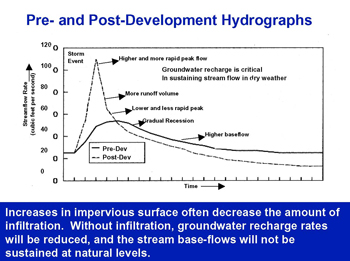Consequences of Current Growth Patterns
A wide range of adverse impacts on the environment, economy and quality of life are linked to the current growth patterns that have resulted in part from federal, state, local policies on housing, transportation and funding.
Environmental
Water Quantity and Hydrology
The effects of urban and suburban runoff are most dramatic when natural land is first developed. Land that was once able to soak up a half-inch of rain or more without a rise in stream levels behaves quite differently after roofs, roads and other impervious surfaces are constructed or created. Examining the hydrograph of a watershed before and after the watershed has been developed reveals the challenges that planners face: greater volumes (Q) of precipitation run off the land more quickly, resulting in a sharp spike in stream levels, which can cause or worsen flooding. High stormwater flows that cause flooding and increased frequency of flooding are associated with urbanization.
Changes to watershed hydrology are also apparent in aquifers and stream networks. The number of stream channels is reduced because stormwater conveyances are used to channel water away from developments. Stream "baseflow," or normal dry-weather flow, is lower because rainfall and snowmelt are not infiltrated and are not available to recharge streams or aquifers. In areas where residents depend on wells for their drinking water supply, underground aquifers can be depleted due to increasing demand from new development and an associated decrease in infiltration as impervious surfaces replace natural land cover. Fewer streams result in sudden large flows from storm events that cause channel erosion and widening. Widely accepted research indicates that stream channels begin to erode when effective impervious cover approaches 10 percent of a watershed. When effective imperviousness exceeds 25 percent, channel erosion and habitat degradation become significant, as well as the potential for contamination of drinking water sources. A large volume of scientific and technical research literature has established the association between impervious surfaces and negative impacts on waterways. In fact, effective impervious surface can be used as an indicator of aquatic health and biodiversity.
![[logo] US EPA](https://www.epa.gov/epafiles/images/logo_epaseal.gif)
